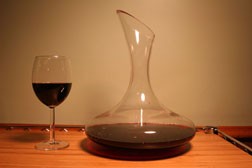Wine Glasses and Decanting
- Share
- Tweet
- Pin
- Share

Public domain photo.
Wine is a living organism; the life of a wine is sped up when in contact with oxygen. As you pour the wine through an aerator, into a decanter or into a glass, wine begins to change. The oxygen releases the flavors and aromas of the wine.
The difference between aerating, decanting and just pouring wine into a glass is the amount of wine exposed to oxygen. Some wines will benefit from more oxygen than others.
Decanting can be used for several reasons:
• To soften the tannins of young, robust red wines that may cover up the fruit
• To open the aromas and expand complex wines with moderate aging
• To help separate sediment from red wines
• For fully aged and mature wines that will be consumed right away
When decanting younger, robust reds as well as complex, moderately aged wines, it may serve well to vigorously splash the wine into the decanter to increase the amount of oxygen exposure.
With removing sediment, the wine should be stored upright for a time before decanting to allow the sediment to fall to the bottom of the bottle. Then the wine can be poured gently into a decanter and the sediment separated more easily. Older wines may be more fragile and benefit from softer pour and even a stoppered decanter.

Public domain photo.
A wine glass is comprised of four parts: the base, stem, bowl and rim. A proper wine glass should have a bowl large enough to comfortably swirl without spilling to allow for ample aeration to release the aromas. A thin lip on the glass as opposed to a thick lip on the glass will allow for a cleaner intake of wine when tasting.
The shape and size of your glassware will also have an effect on the wine. A taller, broad bowl-shaped glass will benefit full-bodied reds such as Cabernet Sauvignon or Syrah by greater oxygen exposure and directing the wine to the back of the mouth. A wide bowl glass with a tapered mouth is used to accumulate wine aromas within the glass for delicate red wines such as Pinot Noir. Chardonnay can benefit from a moderate amount of exposure to oxygen and will benefit from a moderate and shallow glass. Whereas lighter, fresher white needs less exposure and present better in a smaller, more narrow bowl.
Try it out! Take a bottle of your favorite white and red wines and do a little test. Try each wine out of different glasses. First try a plastic glass, then try a wide-rimmed glass, such as a water goblet, then try a couple of differently shaped wine glasses and see what you think. I believe you will see a noticeable difference!
Karl Bradley is the wine sales representative for General Beverage Wines for the Door County area. He has worked in fine dining and wine sales for more than 25 years and has a sommelier certificate from the Court of the Master Sommeliers.
